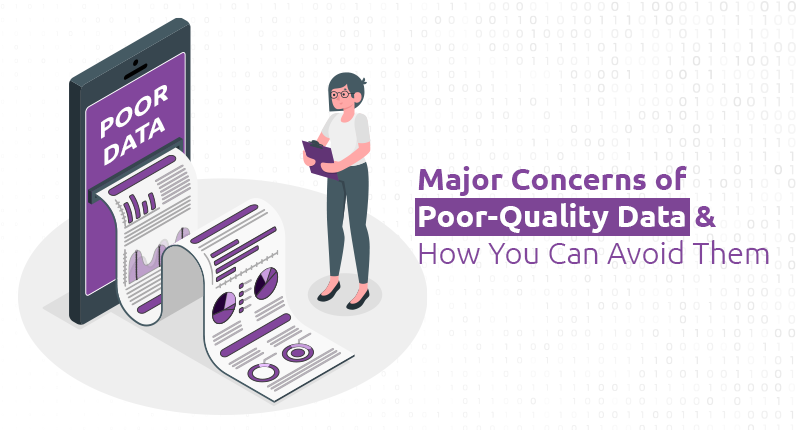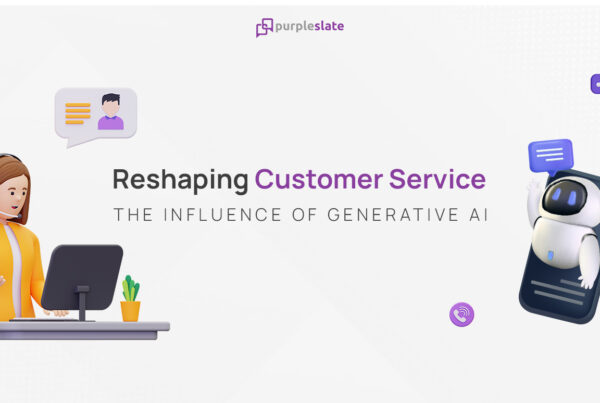
Introduction
Poor data quality is a common problem in almost every organization. Data quality is one of the most critical factors of any data-driven business. Inaccurate, unverified, and inconsistent data can create a lot of problems for any organization. Unreliable data can lead to erroneous decisions, inefficient processes, and low trust from customers or partners.
According to IBM, businesses lose $3.1 trillion annually due to poor data quality
Unfortunately, most people don’t even realize how big of an impact poor data can have on their day-to-day activities until it’s too late.
Poor data quality also has a negative impact on any company’s bottom line. It doesn’t matter how large or small your business is, you will always face some level of data quality issues that are preventable with the right strategy and mindset.
Here we have listed 7 major concerns of poor-quality data and how you can avoid them. Let’s get started!
1) Lack of Visibility into Your Data
You’ll want to make important decisions based on the data in your organization, but if the data is of poor quality, you won’t be able to make the right decisions. Let’s say you’re deciding which customers to pursue and which to ignore. If the data you’re using to make that decision is inaccurate, you won’t be able to make the right decision.
You might ignore customers who would have been interested in your product or service because the data is inaccurate. You might also miss out on opportunities to pursue other customers.
2) Limited ROI From Marketing Activities
You’re investing in marketing activities to build your business, so it’s important to be sure you’re getting the best return on your investment. If your data isn’t accurate, you might be wasting money on marketing campaigns that aren’t effective.
Poor data quality can lead to inaccurate reports and make it difficult to identify which marketing activities are working best. For example, let’s say you’ve been tracking how many leads you get from Google Ads in a spreadsheet, and by any chance if you are not tracking it properly or you miss some data. Then decision-making will be the biggest problem for your management team. It is advisable to use a proper tool to track leads from various sources.
3) Missed Opportunities Due to Incorrect Decisions Based on Poor Data
If you’re using data to make important decisions, but it’s incorrect, you might make bad decisions. This can have a significant impact on your business. You may possibly miss out on new opportunities or lose revenue because of bad decisions.
When you make data-driven decisions based on inaccurate data, you may also have to spend time cleaning up the bad data afterward.
Bad data can lead to missed opportunities in many ways. Let’s say you’re using customer data to decide which customers to focus on. If you miss an error in the data, you might end up targeting the wrong customers entirely. That’s just one example of how bad data can lead to missed opportunities. There are plenty more. Let’s take a look at a few.
- Missed customers – Bad data can cause you to miss out on new customers. If you’re using data to target new customers but you don’t have it properly cleaned and verified, you might miss out on new customers. This can be incredibly costly, so it’s important to get your data clean as soon as possible.
- Missed revenue – Bad data can cause you to lose revenue in several ways. If you’re using the data to make decisions about who to serve, you might lose revenue because you aren’t servicing the customers who actually have a problem with your product.
- Bad decisions – Bad data can lead to bad decisions in many ways. If your data is inaccurate, you’ll make bad decisions based on it. For example, you might decide not to pursue a sale because the data says the customer is outside of your service area. If the data is inaccurate, you’ll end up missing out on that sale.
All of the issues that we have mentioned so far can be grouped under missed opportunities. A missed opportunity is unfulfilled potential. It is something that you failed to achieve. When you are organizing, cleaning, and correcting your data, you are taking advantage of the opportunity to improve it, making it more valuable to your organization and its stakeholders.
4) Loss of Productivity
Inaccurate data can lead to lost productivity in several ways. First, if your data is incorrect, you might make incorrect decisions. If you make decisions based on bad data, you’ll make bad decisions that might cause you to lose customers or lead to the loss of revenue.
That can cause a huge impact on productivity. Poor data can also slow down your employees’ work. If your data is in a bad state, you might need employees to spend extra time cleaning it up. Not just that, if your team is working and making decisions on poor quality of data, then they are just putting a lot of effort into a lost cause. This can have a huge impact on productivity because it takes time away from other activities.
5) Duplicate Data Storage
Duplicate data storage is a very common issue in organizations where people are working in silos and not sharing information with each other. Let’s say that you manage an eCommerce store, and you have your employees enter customer information into a CRM system.
One day, you notice that one of your employees entered incorrect data into the CRM. If that employee never shares the correct information with the other people who are also entering data into the CRM system, the incorrect data will remain in the system. Another scenario that might lead to duplicate data storage occurs when people are creating and storing data in the same system.
For example, let’s say that you work for an e-commerce company, and you want to create a new customer record in your CRM system. You decide to add the customer’s information, including her email address, but you mistakenly type in the wrong email address. If you don’t cross-check your data, it will get stored in the system using the wrong email address.
6) Loss of Customer Confidence
When your customers’ data is incorrect, it can cause a loss in customer confidence. Let’s say that you are an e-commerce store owner, and you have your employees asking customers for their names, email addresses, and phone numbers when they make purchases. Your employees are supposed to enter that information into a CRM system, but one of your employees enter the wrong details by mistake.
You believe that the customer’s data is correct in the CRM system, hence you decide to run a campaign without knowing the information is wrong. You have just lost an opportunity to retain a customer, maybe even convert him/her into a lifelong customer, but instead, he/she is likely to leave negative reviews and discourage other potential customers from purchasing from your store.
7) Mistakes in Poor Data Can Lead to Legal Issues
Poor data will not only lead to missed opportunities but also can create legal issues. An example of this is an insurance company that decides to deny coverage to a customer who is making a claim because of an incorrect data entry.
The customer, who has been injured and is trying to collect money from the insurance company, may decide to take the insurance company to court claiming that the company did not follow the contract and provide coverage. Poor data can get companies into a lot of legal trouble, especially if the data is incorrect and leads to incorrect decisions.
Strategies to Overcome Poor Data Quality
There are several strategies that can help you to overcome poor data quality. These include automated data review and data cleansing. Let’s explore each in turn.
- Automated Data Review – This refers to the process of automatically reviewing the data to identify and flag potential issues, such as fields that contain invalid data. This can be done by setting up data validation rules in your data management system and flagging any issues that are identified.
- · Data Cleansing – Data cleansing refers to the process of fixing errors in the data, such as spelling mistakes and formatting errors. Data cleansing can also involve adding supplemental data, such as values that are missing from fields.
These strategies can help you to improve the data quality of your datasets, thereby making them more reliable and useful. As such, it’s important to account for the fact that, even after you’ve implemented these strategies, there will still be imperfections in your datasets.
Automated Data Review
As discussed above, automated data review refers to the process of automatically reviewing the data to identify and flag potential issues, such as fields that contain invalid data. Automated data review can be implemented in a number of ways.
For example, you can set up data validation rules that flag fields that contain invalid data, such as a date of birth that is outside the expected age range. Also, you can implement rules that check for consistency across different fields, thereby flagging potential issues that might otherwise go unnoticed. For example, you can set up a rule that checks to see if the dates in Date of Birth and Date of Hire are realistic, given the expected life expectancy of the average human being. In such instances, the computer program will flag the inconsistency and notify you of the issue.
Data Cleansing
Data cleansing refers to the process of fixing errors in the data, such as spelling mistakes and formatting errors. Data cleansing can also involve adding supplemental data, such as values that are missing from fields. Data cleansing can be performed manually by someone trained in data management.
Alternatively, you can employ an artificial intelligence program to perform data cleansing. Automated data cleansing can be implemented in a number of ways. For example, a computer program can be programmed to recognize and correct spelling errors. Automated data cleansing can be applied to text data, images, and other media. It can also be used to correct formatting errors, such as dates that are incorrectly formatted. Automated data cleansing can be applied to all your datasets, or only select ones. It can also be applied to individual fields.
Conclusion
As we mentioned at the outset, poor data quality is one of the most critical issues that businesses face today. In order to overcome this issue, it is important that companies create a data quality plan that not only identifies the issues but also provides a roadmap for correcting them.
With the right data quality plan in place, companies can overcome the data quality issues that plague their businesses, in turn enabling them to make more accurate and timely decisions based on accurate and reliable data. Start taking steps to improve data quality as soon as possible.




